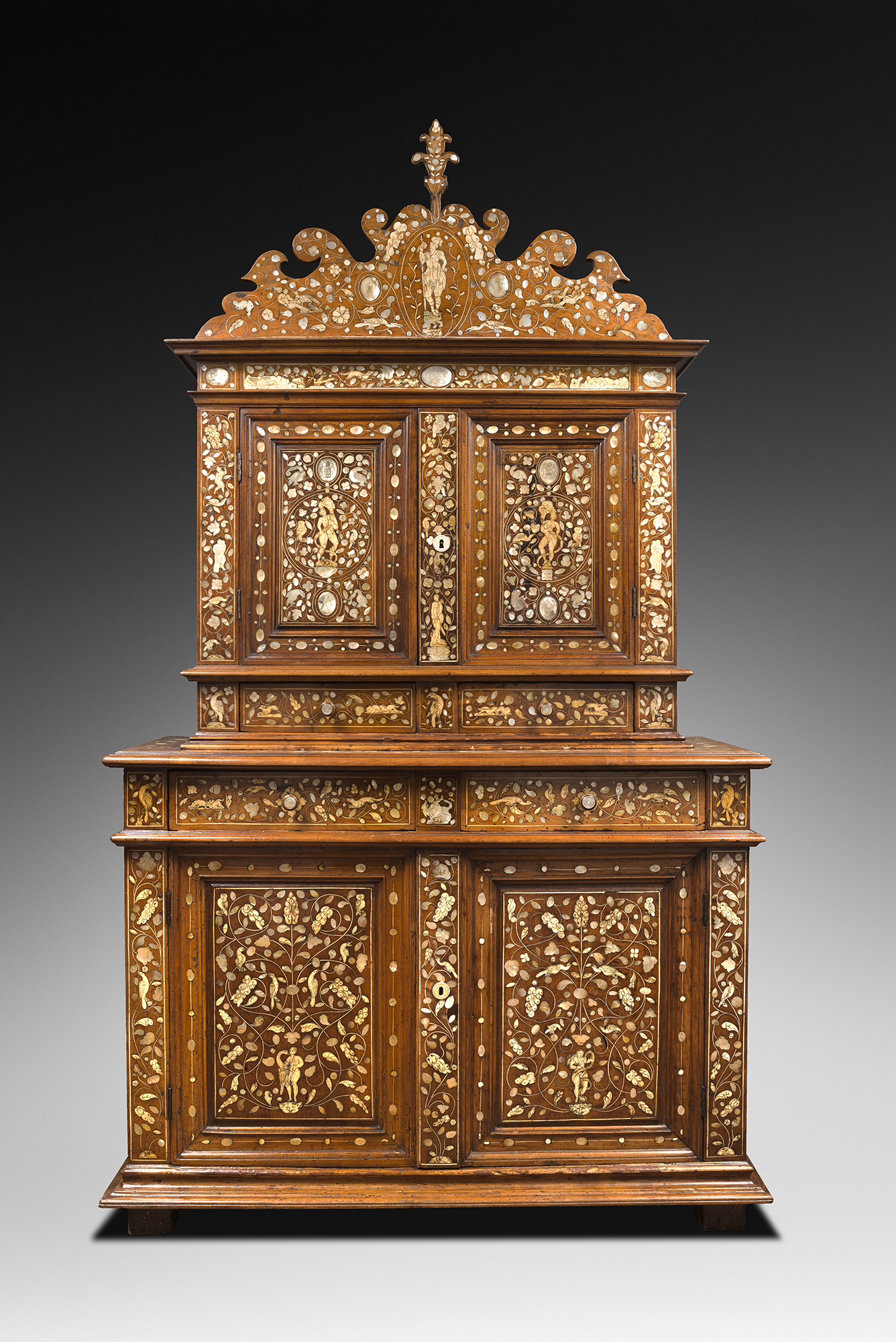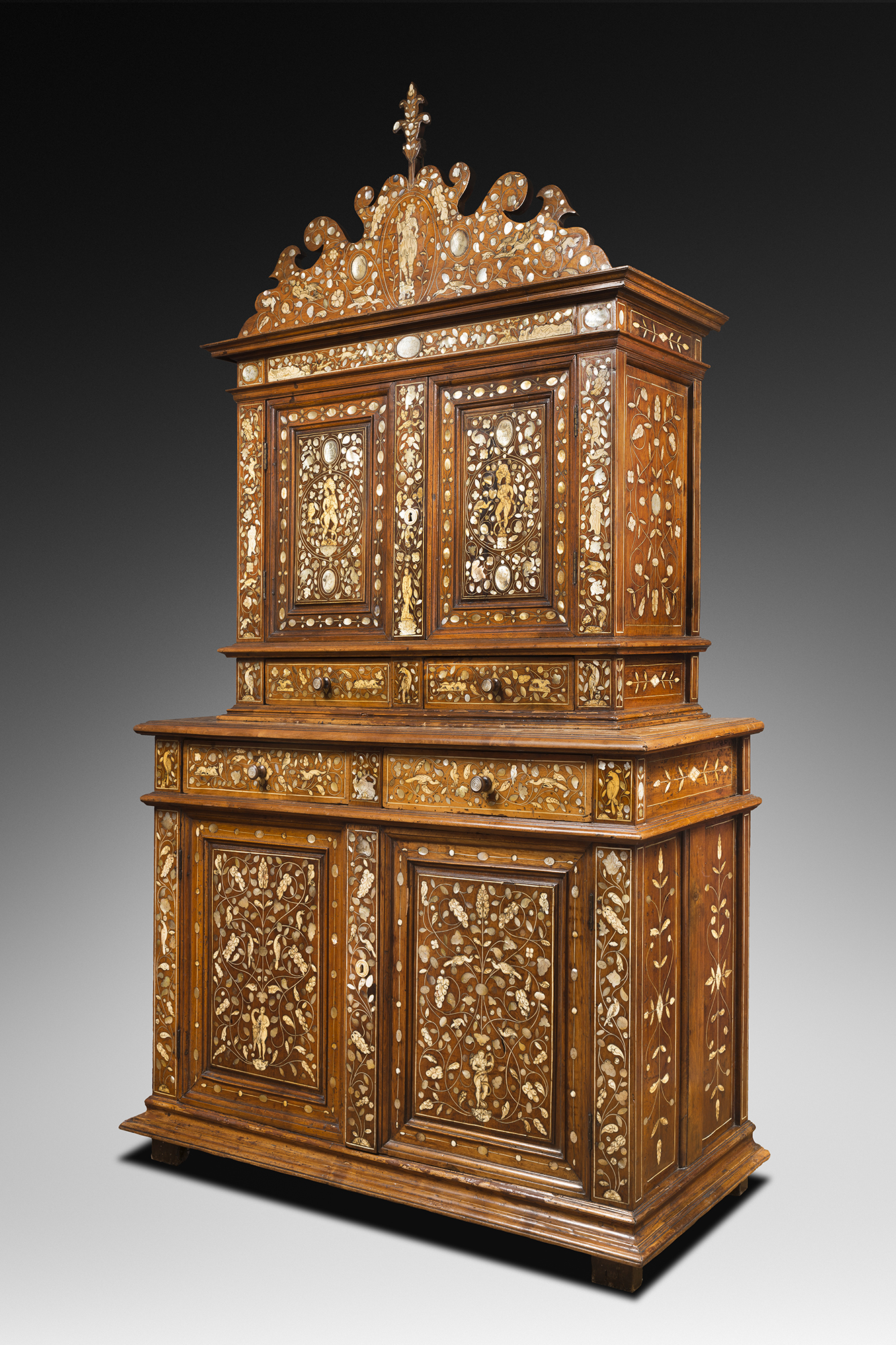Description
Two-bodies dresser, the upper body showing a recess, and opening with four door-leaves and four drawers. The dresser is topped by a fretworked pediment with a vegetal finial. The dresser is adorned with mother-of-pearl and ivory inlays depicting arabesques, animals and allegories. The drawers’ knobs are enriched with ivory and so are the keyholes.
The lower body stands on a protruded moulded plinth over four square feet. It opens with two door-leaves bearing a symetrical but non identical mother-of-pearl arabesques. Supple foliated stems grow on the surface filled with fruits, owls and other birds. The stems spring from a mask on which stands a female figure. On the left door-leave is depicted Leda accompanied by Zeus as a swan. On the right hand side a snake embraces Cleopatra and bites her breast.
The drawer’s facades and the posts also show a mother-of-pearl inlaid decor elaborated on a narrower frame. We can distinguish owls and other birds as well as dogs.
Between the two drawers a winged putto plays with an animal.
The recessed upper body stands on two drawers adorned with an arabesques, dogs and birds mother-of-pearl decor.
The two door-leaves are framed with richly adorned posts where human figures are more represented. Among them can be seen a woman holding a child in her arms, she is the allegory of Charity. On the central post Venus is shown with her son’s weapon, Cupid’s bow. Each door-leave presents a triple arabesque inset composition. The larger inset is centred by the allegory of Abundance holding a cornucopia. On the left door-leave lower inset the mother-of-pearl surface is engraved with a female profile portrait while a bearded man is pictured on the right hand side door-leave. Their coat-of-arms is shown on the upper insets.
The elongated surface of the entablature is filled in with animated dogs, cats and birds as well as three nymphs lying.
The fretworked pediment is also adorned with a triple arabesque inset accompanied by animals. Warriors profiles are engraved on the mother-of-pearl surface while in the centre is standing Mars, god of war, a hand on his hip and the other on his shaft. A cut out vegetal finial inlaid with mother-of-pearl motifs tops the pediment.
Mother-of-pearl arabesque also enrich the lateral sides of the dresser. More airy and geometrical these motifs are also found on the lower-body table top. An engraved mother-of-pearl disk echoes the drawers’ knobs.
This dresser’s decorative system expresses the skills of a particularly gifted ornamentalist who has effortelessly mixed arabesques, animals and mythological references.
The arabesque motif asserts itself in France thanks to Italian artists called by king François Ier (1494-1547) at Fontainebleau’s court. Its decorative repertoire is perfectly adapted to Fontainebleau’s craze for ornaments. Arabesque evolves by forsaking its botanical abstraction – acorns can be seen on our dresser – and by involving animals and human figures.
The arabesques’ curves and volutes and the pediment’s fretworked silhouette are particularly efficient in softening the architectural rigour of the dresser, typical of the 2nd half of the 16th century. The blond walnut, the lavishness of the decor and the luxury of materials connect this dresser with the Loire valley and illustrates a high-rank order. Indeed this type of furniture was intended for the higher classes.
Thanks to the coat-of-arms engraved on the right hand side door-leave (au lion a la fasce chargée de trois cœur) the patron’s family can be identified as the Herissem, a noble family coming from the former Netherlands, today in Belgium.
Because of the couple’s portrait and both families’ coat-of-arms as well as the themed decor this dresser was undoubtedly ordered as a wedding gift. The depiction of Leda and the swan and the suicide of Cleopatra emphasize a certain sensual aspect while Venus figured having seized her son’s bow expresses a chaste love. The Charity and Abundance’s allegories point towards the virtues to favour as well as the dogs embodying faithfullness. The several owls, attribute of Minerva, express wisdom. The frequent depiction of military figures – Mars, warriors – contrast with love figures and embodies the balance to find in the marital couple.
The geographic distance between the production centre and the patron highights the prestige furniture from the Loire valley had, as well as the means and the taste of the Herissem couple. The dresser’s iconography chracterizes the Renaissance period with its artistic exchanges and its fondness for classical culture. Finally this dresser is also an astounding exemple of the cabinet-makers and ornamentalists’ know-how during the late 16th century.


